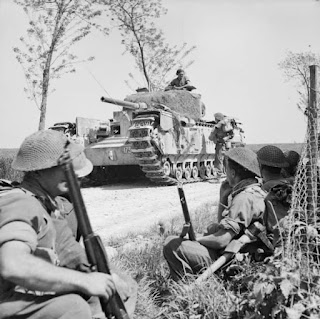In April 1945 the Allied armies in Italy launched Operation Grapeshot to conquer the northern portion of that nation and destroy the Axis forces located there.
In April 1945 the Allied armies in Italy launched Operation Grapeshot to conquer the northern portion of that nation and destroy the Axis forces located there.
As covered in an earlier post, this operation was entirely successful, and by the 25th both Allied Armies had reached the Po River having collected some 54,000 prisoners in the process.
For the remainder of the month the Allies moved quickly to exploit this growing victory. Already, elements of the American Fifth Army had crossed the Po River on 23 April, and over the next two days the British Eighth Army followed suit. From there, the Allies raced forward to complete their liberation of Northern Italy.
By this stage in the campaign, order and discipline within the German army had largely disintegrated, and the Allies were able to make great gains against minimal or sporadic resistance. Assisting them in this process was a massive uprising by Italian partisans that exacerbated the situation for the Germans.
One by one the major cities in Northern Italy fell to the Allies as prisoners in the thousands and tens of thousands flowed into their cages each day. This was particularly true for the American Fifth Army, which made widespread gains throughout the region.
Spearheading the advance for the Eighth Army was a reinforced 2nd New Zealand Division, which made a dash to Monfalcone and Trieste on the Adriatic coast collecting over 30,000 prisoners in the process.
On their left flank, the British 6th Armoured Division advanced to Vittorio Veneto, Udine and the border area adjoining Yugoslavia and Austria while collecting a further 20,000 prisoners. On their right, the 8th Indian and British 78th and 56th Divisions made shorter advances culminating with the latter’s capture of Venice and the seizure of 3,000 additional prisoners located there.
This period also saw the final acts of the local maritime struggle as the Germans scuttled or surrendered the remaining warships still under their control. Even before this occurred, on 19 April Italian-manned Chariot human torpedoes enter Genoa harbour and sank the nearly completed aircraft carrier Aquila to prevent it from being used as a blockship.
Five days later the Germans carried out a mass scuttling in Genoa that accounted for the destruction of over 50 warships (most of which were non-operational or under construction) including seven destroyers / torpedo boats, nine corvettes and two submarines.
While this represented the largest such demolition, the Germans carried out similar activities in other ports including the scuttling of a fast escort at Oneglia, a destroyer at Imperia, a submarine at Monfalcone and four torpedo boats at Trieste. Finally, on 3 May the last seven German E-boats remaining in the region departed Pola and proceeded to Ancona to surrender.
With this, the last semblance of German maritime power in the Mediterranean ceased to exist.
Coinciding with this event was an equally conclusive outcome for the German ground forces still present in northern Italy. On 27 April Italian partisans captured the Fascist dictator Benito Mussolini near Lake Como and summarily executed him the next day.
On the 28th representatives from German Army Group C arrived at Field Marshal Alexander’s headquarters in Caserta to negotiate an end to hostilities. The next day these authorities signed a document of unconditional surrender for all German forces in Italy to be effective at 1400 hours on 2 May.
In the interim the Allied armies continued their northward advances, and by 2 May the Allies had taken 145,000 prisoners since the start of their spring offensive (including prisoners already mentioned). Now with the advent of this comprehensive capitulation, a further 260,000 Germans laid down their arms.
Added to this were upwards of 160,000 Fascist Italians that were captured during the final offensive or its immediate aftermath. Meanwhile, Axis equipment losses included 261 tanks, 475 self-propelled assault guns, 1,429 assorted artillery pieces, 345 heavy anti-tank guns and 572 infantry close support guns.
These events concluded the struggle for Italy, and shortly thereafter the entire Mediterranean conflict came to an end. In the previous 20 months (beginning on 9 September 1943) the defence of Italy had cost the Germans some 735,000 casualties including those sustained during the mass surrenders in late April and early May 1945.
Added to this loss were roughly 200,000 Fascist Italians and other Axis contributors who had provided security and logistical support to the German cause. Excluding enemy forces that were disarmed at the end of hostilities, Eighth Army’s contribution to this combined total included 104,408 prisoners taken during the duration of the fighting (from 3 September 1943) while an additional 16,443 prisoners were taken by the British elements assigned to the Fifth Army.
For their parts, the American, French and Brazilian contingents within the Fifth Army combined to take a further 219,660 prisoners during the same period. In achieving this substantial victory, the Allied armies in Italy suffered 313,495 casualties of which 159,651 came from British or British-affiliated forces.
Pictured here is a Churchill tank near infantry of the 1st London Irish Rifles during Operation Grapeshot in April 1945. No 2 Army Film & Photographic Unit, Palmer (Sgt), Public Domain. For more information on this and other related topics, see Blue Water War, the Maritime Struggle in the Mediterranean and Middle East, 1940-1945.











Comments
Post a Comment